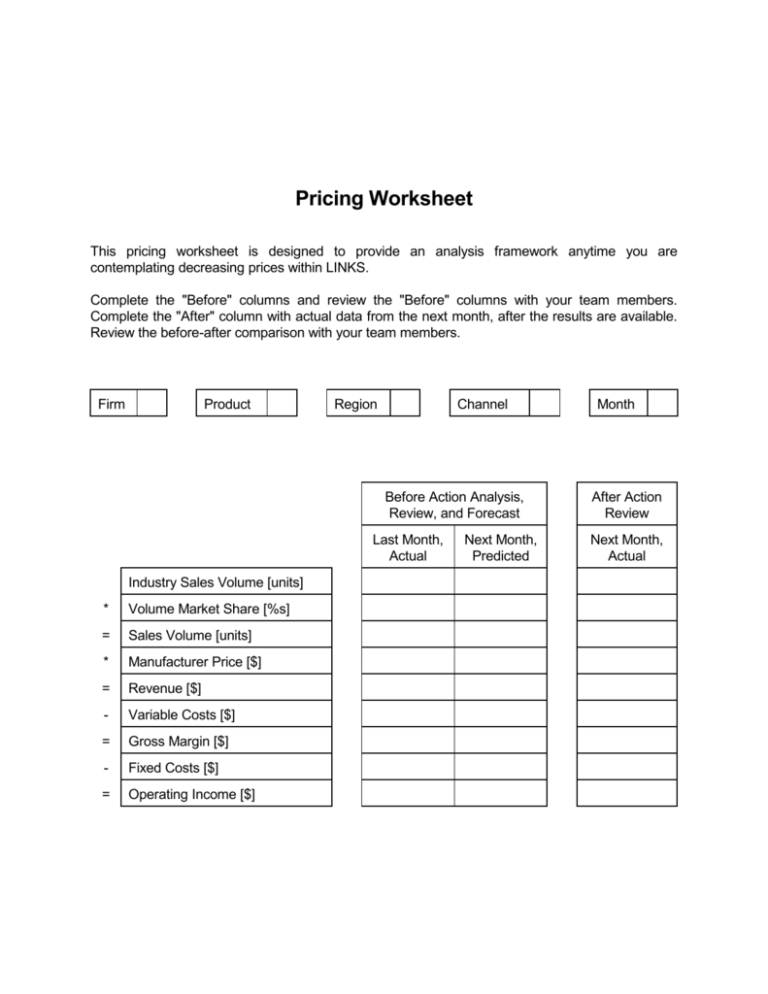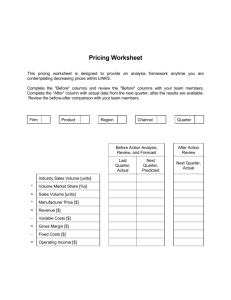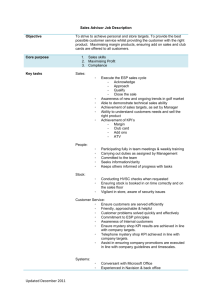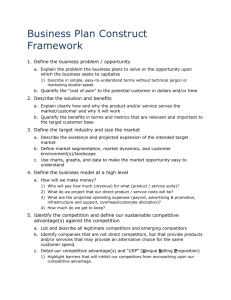LINKS Supply Chain Management Simulation
advertisement

Pricing Worksheet This pricing worksheet is designed to provide an analysis framework anytime you are contemplating decreasing prices within LINKS. Complete the "Before" columns and review the "Before" columns with your team members. Complete the "After" column with actual data from the next month, after the results are available. Review the before-after comparison with your team members. Firm Product Region Channel Before Action Analysis, Review, and Forecast Last Month, Actual Industry Sales Volume [units] * Volume Market Share [%s] = Sales Volume [units] * Manufacturer Price [$] = Revenue [$] - Variable Costs [$] = Gross Margin [$] - Fixed Costs [$] = Operating Income [$] Next Month, Predicted Month After Action Review Next Month, Actual Judgmental Sales Forecasting Worksheet Sales forecasting drives everything in the supply chain. Unfortunately, sales forecasting is extraordinarily challenging due to the many factors influencing your sales (your current and recent generate demand programs, current and recent competitors' generate demand programs, and exogenous market forces). Here's a judgmental sales forecasting process that, at a minimum, provides an organizational template to systematically approach the sales forecasting process. Judgmental adjustments are challenging, but at least you're explicitly taking into account that your generate-demand program changes, and those of your competitors, influence your sales. Step 1 (the "easy" part): Construct a trend-line extrapolation of past sales realizations based on a crucial assumption: future market and environmental forces will continue as they have existed in the recent past. Be watchful for structural considerations like channel loading (forward buying), unfilled orders, and backlogged orders. Step 2 (the "hard" part): Make adjustments for planned changes in your generate demand programs. The potential impacts of changes in product, price, distribution, communications, and service on your sales must be quantified. Step 3 (the "subtle" part): Account for foreseeable competitors' changes in their generate demand programs. It's easy to overlook competitors in forecasting. Assume that competitors are vigilant and thoughtful and present. 1 Trend-Line Extrapolation of Past Sales Realizations (Base-Line Forecast) 2 Adjustments For Planned Changes In Generate Demand Program (list specifics, with judgmental estimates of sales impacts [expressed in +/- %s]) Product Changes Price Changes Distribution Changes Communications Changes Service Changes 3 Adjustments For Foreseeable Changes In Competitors' Generate Demand Programs (list specifics, with judgmental estimates of sales impacts [expressed in +/- %s]) Product Changes Price Changes Distribution Changes Communications Changes Service Changes Adjusted Sales Forecast SWOT Analysis Worksheet Strengths Weaknesses What are your firm's strengths relative to your competitors? What are your most important strengths? Why? What are your firm's weaknesses relative to your competitors? What is impeding you from achieving your desired results? Prioritize your weaknesses. Opportunities Threats How can you convert these strengths, weaknesses, and threats into opportunities for your firm? What considerations are most important for your success? What organizational, competitive, and environmental threats do you face now and in the near future? KPI Worksheet Firm Month Key Performance Indicators (KPIs) are central to managing processes and sub-processes, such as those that comprise supply chain management. Use this worksheet to analyze a specific subprocess for your LINKS firm. Develop specific action plans for improving your performance on this KPI. What KPI? How/Why Is This KPI Relevant To Customers and Customer Requirements? Why Is This KPI Noteworthy Now? What Is Your Standing on This KPI Now? What Are Leading/Key Competitors' Standings on This KPI Now? What Is Your KPI Future Objective? What Can You Do To Influence This KPI? (What Drives This KPI?) What's Your Specific Action Plan To Achieve Your KPI Future Objective? Supply Chain Management Scorecard Organizational Performance Poor Agility Respond to short-term changes in demand or supply quickly; handle external disruptions smoothly. Adaptability Adjust supply chain's design to meet structural shifts in markets; modify supply network to strategies, products, and technologies Alignment Create incentives for better performance Excellent Promote information flow with suppliers and customers 1 2 3 4 5 Develop collaborative relationships with suppliers 1 2 3 4 5 Design for postponement 1 2 3 4 5 Build inventory buffers by maintaining a stockpile of inexpensive but key components 1 2 3 4 5 Have a dependable logistics system or partner 1 2 3 4 5 Draw up contingency plans and develop crisis management teams 1 2 3 4 5 Monitor economies all over the world to spot new supply 1 2 3 4 5 Use intermediaries to develop fresh suppliers and logistics infrastructure 1 2 3 4 5 Evaluate needs of ultimate customers, not just immediate customers 1 2 3 4 5 Create flexible product designs 1 2 3 4 5 Determine where companies' products stand in terms of technology cycles and product life cycles 1 2 3 4 5 Exchange information and knowledge freely with vendors and customers 1 2 3 4 5 Lay down roles, tasks, and responsibilities clearly for suppliers and customers 1 2 3 4 5 Equitably share risks, costs, and gains of improvement initiatives 1 2 3 4 5 Source: Hau L. Lee, "The Triple-A Supply Chain," Harvard Business Review (October 2004).







